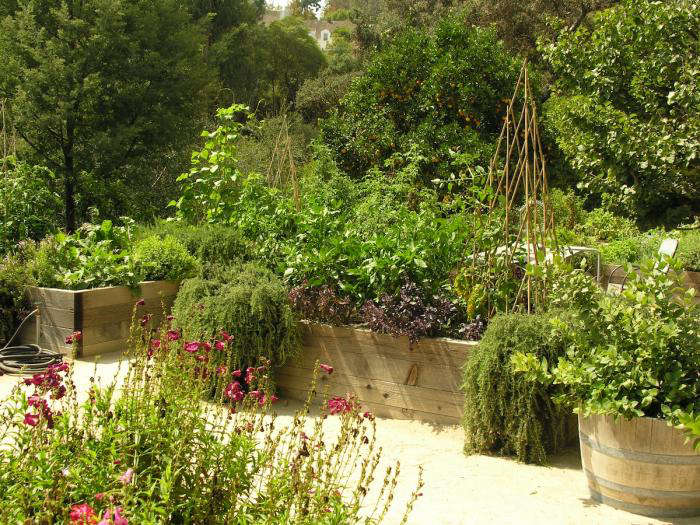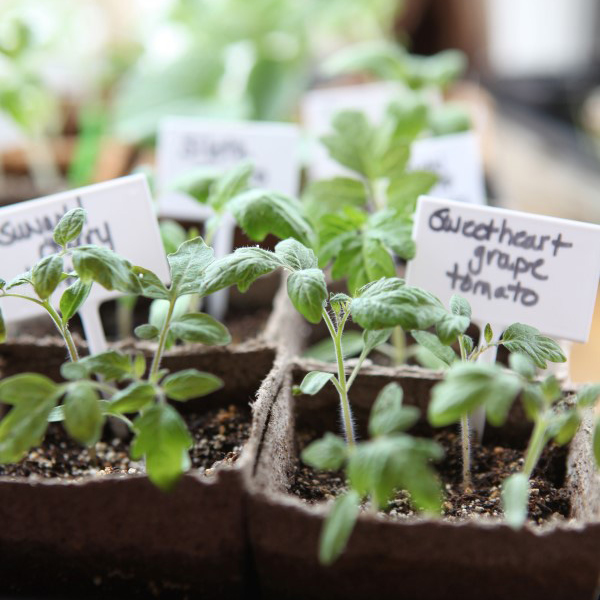This week, we are revisiting some of our favorite summer-centric Gardenista stories. Remember this one?
According to Santa Monica-based landscape designer Art Luna, owner of Art Luna Garden, every kitchen garden is a true labor of love. Growing a source of food requires constant care and attention. Below, he walks us through several of the edible gardens he’s created for clients, sharing some of his tips for the raised garden bed, a feature universal to his projects. “Fruits and vegetables like a controlled temperature,” he says. “When you raise the kitchen garden, you can control the temperature of the soil,” thus making for a healthier and more thriving bounty. More of Art’s insights unfolds below.

Above: In essence, a “kitchen garden’” is a functional garden that grows edible herbs, flowers, vegetables, and fruits. According to Art, when produce is grown directly in the ground, the earth’s temperatures can fluctuate, often becoming very cold or hot; it can even become too hard, which can lead to inadequate water penetration.
Growing crops in a raised setting offers more control in maintaining the soil temperature; there is also a convenience factor: “It’s easier to harvest when they’re high,” says Art. For this garden located in the Bel Air community of Los Angeles, Art incorporated timber beds that are approximately 24 inches off the ground, which are “a bit higher than most,” he says. (For each kitchen garden he designs, Art turns to Pam Rownak of Culver City, CA, who is the talent behind physically installing, and often maintaining, the edible produce.)

Above: Art punctuated the space next to the raised timber beds with wine barrel planters (a kumquat tree thrives in the front right barrel). A popular choice for many kitchen garden growers, these can be sourced at most local nurseries. “These are great for kitchen gardens. It’s a nice alternative for anyone who doesn’t have the space.”

Above: For this Bel Air garden, Art covered the sides of the raised beds with Rhaphiolepis umbellata minor, which he describes as a “course, more textured boxwood.” On the left, an old Anduze pot holds a fig tree.
He also planted a mix of edible plants and cutting flowers, ultimately designing a space where his clients can enjoy the benefits of both. “It’s nice to have a garden that is both a cutting garden and a kitchen garden at the same time.” Three beds were dedicated to growing flowers meant for cutting and enjoying elsewhere. The result is a rich, full garden.

Above: This photo was taken early on in a garden’s life, a mere three weeks after the initial planting. Art employed a strategic element here: copper edging around the top and edges of the beds. “This is a nice deterrent for pesky little insects,” he says. “It helps prevents the snails from going into the garden.” The tuteurs are made out of teak, which will eventually be completely covered with growing vines.
Art and his team look to the most organic means possible when caring for their gardens. Two natural methods he employs are neem oil, a natural insecticide, and worm castings “tea”, a blend of worms’ end products that are highly nutritious for plants.

Above: Last, a kitchen garden in the Brentwood community of Los Angeles with raised beds made of stone. “That’s the ultimate snail border,” says Art. Because of their slime, they can’t make their way up the stone. As seen in this space and the previous three, adequate sunlight, at least six hours per day, is essential for growing a successful kitchen garden, says Art.
See also:
N.B.: This post was first published in October 2012.
(Visited 6,003 times, 33 visits today)
Frequently asked questions
What is a kitchen garden?
A kitchen garden is a small area of land, usually near the house, dedicated to growing a variety of herbs, vegetables, and fruits that can be used for cooking and consuming fresh produce.
Why create a kitchen garden?
Creating a kitchen garden allows you to have easy access to fresh and organic produce, reduce grocery bills, and enjoy the pleasures of gardening and cooking with homegrown ingredients.
What factors should be considered when designing a kitchen garden?
When designing a kitchen garden, it’s important to consider sunlight exposure, soil quality, water availability, and proximity to the kitchen to ensure optimal growth and convenience.
How do you maintain a kitchen garden?
Maintaining a kitchen garden involves regular watering, weeding, mulching, pruning, and fertilizing. It’s also essential to monitor the plants for pests and diseases and take necessary actions to control them.
What are some popular plants to grow in a kitchen garden?
Popular plants to grow in a kitchen garden include herbs like basil, rosemary, and parsley; vegetables like tomatoes, peppers, and lettuce; and fruits like strawberries and blueberries.
Can I create a kitchen garden even if I have limited space?
Yes, kitchen gardens can be created in small spaces like balconies, rooftops, or even window sills using containers, vertical gardens, or raised beds. Compact and dwarf varieties of plants are ideal for limited space.
How do I start a kitchen garden from scratch?
To start a kitchen garden from scratch, determine the available space and sunlight exposure, prepare the soil by removing weeds and adding compost, select suitable plants based on your preferences and climate, and provide regular care and maintenance.
Are there any benefits of companion planting in a kitchen garden?
Yes, companion planting in a kitchen garden has several benefits. It helps deter pests naturally, improves pollination, conserves soil moisture, and maximizes space utilization by planting compatible plants together.
Can I use organic methods to maintain my kitchen garden?
Absolutely! Organic methods such as using compost, natural fertilizers, beneficial insects, and practicing crop rotation can be employed to maintain a kitchen garden without the use of synthetic chemicals.
How long does it take to see results in a kitchen garden?
The time it takes to see results in a kitchen garden depends on various factors, including the plants selected, growing conditions, and care provided. Some crops may yield results in a few weeks, while others may take months.


